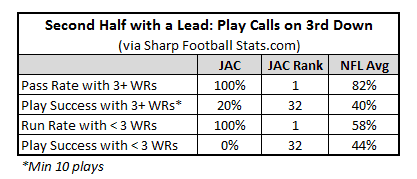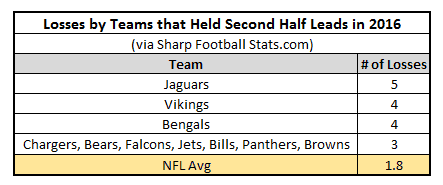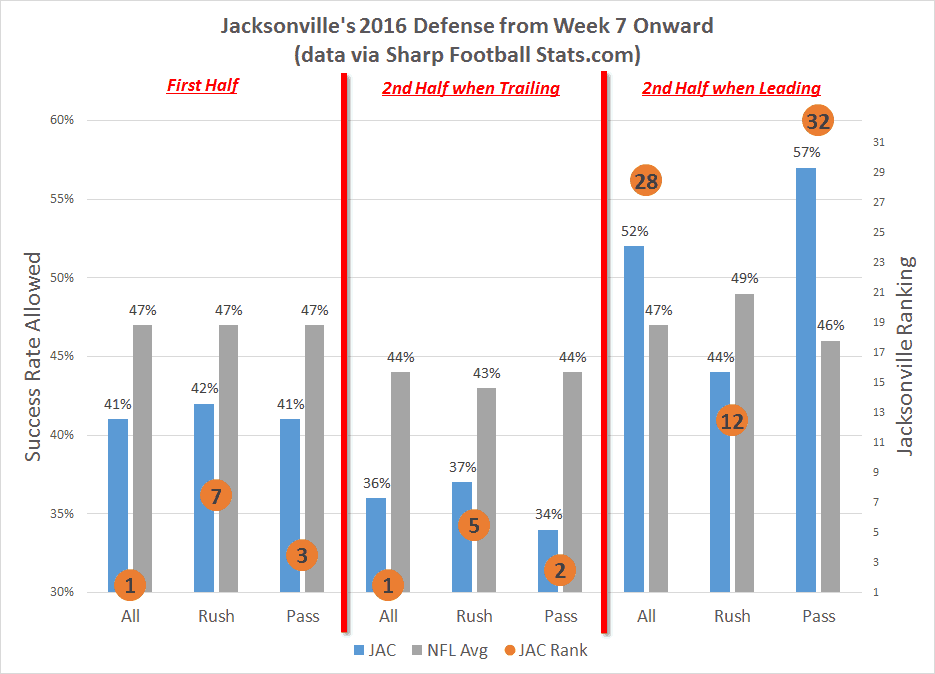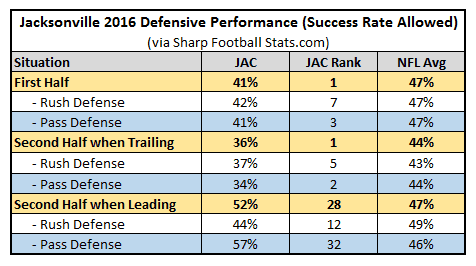It's hard to win games in the NFL. It's harder for a team like the Jaguars, led by Blake Bortles, to win games. If fortunate enough to play the game successfully so as to hold a lead in the second half, a team like the Jaguars must play intelligently with a lead. That's because it's easier for a team like the Jaguars, led by Blake Bortles, to lose that lead. A team won't win many games when playing with a second half lead and using highly predictable offense and extremely soft prevent pass defense. Especially a team like the Jaguars. But that is exactly what the Jaguars did last year. And what happened? The Jaguars blew second half leads in a NFL-high 5 games from week 7 onward last year.
The Jaguars started out 2-3 last season, with narrow losses to the Packers (4 points) and the Ravens (2 points). They actually held a second half lead over the Ravens before blowing that lead. Once Nathaniel Hackett took over as the offensive coordinator, the Jaguars vaulted into the most pass heavy team in the NFL when leading in the second half. They passed the ball on nearly 60% of their offensive plays. It was a ridiculous rate considering two things. First, the NFL average was only 45% pass. Second, they were terrible when they did pass. Bortles was successful on only 37% of his passes and delivered a terrible 58.6 rating when passing in the second half. When leading in the second half, the NFL average was a 45% success rate and a 92.3 rating on passes.
Typically a team with the lead in the second half may face more third downs than normal, because they are less focused on early down efficiency and more focused on running out the clock. This puts extra emphasis on 3rd down efficiency. It makes it more vital to be productive on 3rd down, because if you fail, you're likely kicking the ball back to your opponent.
So how did Jacksonville fare on 3rd down in the second half with a lead? They were music to a defensive coordinator's ear. Examine these numbers:
- With 3+ WRs on the field, they passed the ball 100% of the time and were always lined up in 11 personnel.
- The predictable nature made it easy on defenses, and Bortles delivered just a 20% success rate and a 42 passer rating on 3rd down in the second half with a lead.
- With less than 3 WRs on the field, they ran the ball 100% of the time, from either 12 or 13 personnel.
- The predictable nature was so terrible that they recorded a 0% success rate on these runs.
Defenses knew exactly what Jacksonville was going to do on 3rd down when leading in the second half simply based on who they sent onto the field. And as a result, they were the least successful offense in the NFL in these situations. They were successful on just 20% of their third downs when leading in the second half. This is why their opponents always had opportunities to come back in games. This is why the Jaguars lost a NFL-high 5 games from week 7 (when Hackett took over) to the end of the season despite leading at in the second half in those games.
The maddening thing about their third down performance was that on early downs, they were actually better than average. On early downs with a lead in the second half, the Jaguars were successful on 48% of their offensive plays, which was better than the 47% league average. They faced third and an average of 6.5 yards to go, which was actually ranked 6th best in the league. The average was 7.2 yards to go on third down in the second half when leading. While that may sound bad (6.5 yards to go seems unmanageable), only the Steelers, Redskins, Cowboys, Cardinals, Chargers and Broncos were better offensively last year. Jacksonville averaged 4.8 yards per play on these early downs, which was above league average (4.69). They were not very explosive on these early down calls, thus they did not bypass 3rd down as often (recorded new first downs on 17% of their early down calls, 8th worst in the NFL and below the 21% average).
Jacksonville must be more creative when leading in the second half. In 2016, Hackett tipped his hand like you wouldn't think is humanly possible. On any down, if they had fewer than 3 WRs on the field, they ran the ball 100% of the time, gained just 1.7 yards per carry and they posted a success rate of just 29%. In large part due to the Jaguars predictability, the defense knew what was coming, and it directly cost them. The NFL average with less than 3 WRs was 74% run, with a run success rate of 40% and 3.2 yards per carry.
The problem for the Jaguars wasn't entirely related to Hackett and the third down play calling, although inevitably there is a spillover effect from poor offense into a defense. From week 7 onward in the first half, take a look at the Jaguars defense in the following situations, first visually, then in tabular format:
The Jaguars defense was the #1 defense in the first half and they were #1 in the second half when the Jaguars were trailing. However, when they were leading, while their run defense was close to their first half rate of success, their pass defense dropped all the way to the NFL's worst, allowing a whopping 57% success rate to opponents. If there ever has been a way to visualize what a prevent defense looks like, it is on the graphic above. Examine how truly mind blowing it is for the 3rd ranked first half pass defense and the second ranked second half pass defense (when trailing) to drop to the league's worst when leading. This again relates to play calling, but in this case it is the fault of play calling from defensive coordinator Todd Walsh.
On both sides of the ball, play calling was a prime element which cost the Jaguars 5 games from week 7 onward that they lost despite leading at some point in the second half. In these games, there is no doubt that play calling was a major reason the Jaguars gave up these second half leads. But it is not entirely the fault of the coaches. The players made mistakes and need to clean up elements of their execution when playing with a lead late in the game.
But as Jacksonville's training camp opened the focus has been on quotables from the team about winning or making a trip to the Super Bowl. Calais Campbell said “all the pieces are in place” to win the Super Bowl, and Malik Jackson took it a step further and said he expects the Jaguars will win the Super Bowl this year. But to win the Super Bowl, the Jaguars must win games. And to win games, they have to figure out how to play with a lead in the second half.
This week, Head Coach Doug Marrone gave the following response when asked how many times a game quarterback Blake Bortles will attempt passes:
“Zero.” [He said he wasn’t joking about this, and he wasn’t smiling when he said it.] “For me, I’d like to run the ball every play. I want to go back to the old way. I want to change the game.”
This is concerning from the very fact that the Jaguars, as described above, appear to have extremely little creativity on play calling, and are very single-minded based on personnel groupings in the game. There is no doubt minimizing the influence of a poor quarterback like Bortles would be in the Jaguars best interest. But that means all the more reason for the Jaguars to involve disguise and deception with their play calling. They clearly did anything but that in 2016.
In 2016, the Jaguars recipe when playing with a lead in the second half was highly predictable formations and play calls offensively, and utterly painful prevent pass defense. That combination caused them to lose 5 games that they led in the second half. And that cannot repeat itself in 2017 if the Jaguars want any hope for a winning record, let alone winning a Division Championship, Conference Championship and the Lombardi.
About the author: Warren Sharp ( @SharpFootball ) owns and operates SharpFootballAnalysis.com and SharpFootballStats.com



















